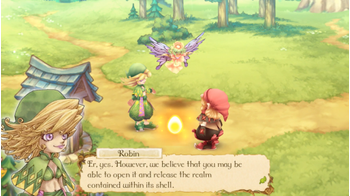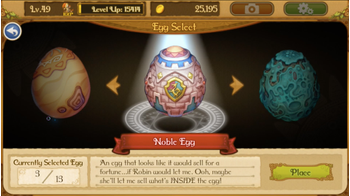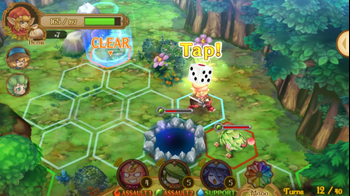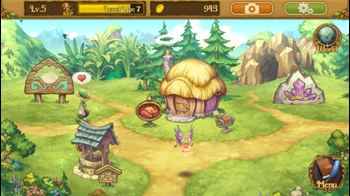
Egglia: Legend of the Redcap Review
I feel it needs to be said that Egglia: Legend of the Redcap is a full-scale RPG adventure, not some free-to-play, microtransaction-heavy concoction that has flooded the mobile marketplace. Because of that, it is a paid app, but with the price tag comes a fantastic adventure that calls back to the days of yore (let’s say the PlayStation 1 era).
This was a time when the concept of blending 2D and 3D visuals was a novel idea that worked together to create an experience that was as eye-catching as it was highly memorable. I say this because you really don’t see many professional examples of this done in the style this game presents.
It helps that Egglia is made by some of the key staff behind the Mana series, including producer and character designer Shinichi Kameoka. Anyone who has seen the screenshots for the game may have noticed how instantly recognizable his art style is for those who have grown up playing Mana games. That being the case, there are some familiar trappings of other mobile titles that keep it from setting itself apart from the crowd.
Let's start from the very beginning. Thea protagonist is a "redcap" goblin, a creature known for having very violent and murderous tendencies. After taking a nasty fall, you lose your horns which are said to be the source of this aggressive behavior. You wind up in an open field and are quickly discovered by an elven girl named Robin and her fairy friend, Marigold. After explaining what happened, you learn they are on a journey to revive the Kingdom of Egglia after it was destroyed following a devastating war.
It turns out the world has been divided into special items called Niebel Eggs. Anyone who has played Legend of Mana with its Land Make system may already know where this is going. Every so often during the story, you will acquire one of these eggs. These are basically artifacts you can drop onto a world map to open up new lands. By placing them in a certain way, you have the chance to unlock even more areas to explore, thus restoring the once barren world back to its original state.
There are also opportunities to build relationships which the townsfolk. By talking to certain people, you are granted the option to either perform a request or give them a present. This helps to improve your friendship with that person who will hand over a gift in return.
Each gift will get a certain reaction from the recipient: neutral, like, and love. Because of that, you have to put some real thought into your offerings. This friendship system of offering gifts and doing tasks allows you to develop close bonds with those you meet during your travels, going from acquaintances to something more.
You can bring your friends along with you, and they can help locate more materials while also giving you a nice stat bonus. The stronger your relationship is with that person, the better the materials and the higher the stat bonuses are.
Each of your friends has their own energy meter that depletes every time you ask for help, and if they run out of energy, you won't be able to request their assistance until they take a rest. Over time, you'll make more and more friends, making this otherwise negative attribute a trivial one. The townsfolk you recruit will also earn experience points.
Where things get interesting is the way the "combat" itself operates. Everything is laid out like a board game. You are presented with a hex-based grid, somewhat similar to the Civilization series. Only here, you have to roll a dice in order to find out how far you can advance. All the while, you have to take into account how you want to approach each target.
The goal is to reach a designated cell in order to complete the stage. As you move towards your destination, there are trees to cut down for important lumber materials, treasure chests to open, and of course, enemies to encounter. The damage you deal with those enemies depends on how high a number you rolled. You only have a limited number of turns you can take before it is Game Over, but there are some neat perks from being quick about it or by completing certain objectives along the way. It's a fascinating twist on what is otherwise an archaic structure that puts your actions up to chance.
By that same token, you may have a string of rotten luck and continuously roll low numbers, leading to dangerous situations with monsters and mission failures beyond your control. However, this design of only having to focus on tapping your screen means it's perfect to play one-handed, which is great for those you don't want a game that always requires your full attention at every possible moment.
This is really the crux of the entire routine: go out, complete these maps, come back, and perform different tasks. But it's fortunately much more than that. For one thing, you won't have to go it alone. Early on, you’re given the chance to summon spirits to fight alongside you by giving them certain types of cuisine they may enjoy. Higher level spirits require more complex recipes made from items you have collected. Much like the Mana Spirits, they are made up of different elements.
There are three spaces you can assign your spirits into - two Assault slots and one Support slot. The spirits that make up your Assault group will boost your HP and Attack stats while giving you new offensive spells to use in the field.
Likewise, the Support spirit will raise your HP and Defense while giving you new support spells. Every Spirit has an associated Spirit Cost that feeds into your maximum cost, but this amount grows as you level up. Using certain spirits together activates Link Runes, boosting their effectiveness in different ways. It’s another interesting feature, although it can sometimes get in the way of your ideal set-up having to work around a strict cap.
Once you’re done with a few maps, you’ll level up and head back to the main town hub. Here, there are different places to visit and people to talk to. You can upgrade different structures which will unlock new features and items. There’s a mailbox containing login bonuses and campaign incentives, along with ways to harvest potatoes and jewels to help Spirits grow and evolve, respectively. You can even decorate your home with furniture, though there doesn't appear to be any inherent benefits from this - it's just neat from a cosmetic perspective.
As a result, there is this unshakable feeling that this is very much a free-to-play mobile game no matter how hard it tries to break from its boundaries. Much of its design is rigidly structured like this making it have this identity crisis. It doesn’t know what it really wants to be, or the developers changed their direction halfway into the project.
It feels like just as soon as you start to become comfortable with the familiar framework of a traditional RPG, you’re blindsided by a bevy of cooldown timers. Because of these timers, you're required to have a persistent online connection when playing the game, which works to undermine that nice, familiar feeling. At least things lean far more in your favor than the typical free-to-play experience, but this can still be a real distraction from what the game has to offer.
I must say, the localization is incredibly charming. While it can get a little too hamfisted (and downright cheesy at times), every single character exudes a unique personality that is delicately crafted to a strong degree. This is important because that’s exactly what good localization is supposed to do. It’s more than simply translating a piece of dialogue.
The team behind the English script clearly took the time to give each person their little quirks and traits that helped set them apart. It may not always hit its mark, but there were more than a few times where I had myself a good chuckle with the lighthearted humor while being pulled in by the tense drama that unfolded as the plot carried on.
This appeal carries over to the soundtrack with its abundant amount of whimsy and pleasantness. I found myself simply putting my phone down with the volume all the way up so I could get carried away by the downright beautiful tunes. That's because it was created by famed composer Yoko Shimomura - one of the true greats in the industry. This alone makes the game worth playing just to witness some really delightful compositions.
While the gameplay is overly simplified, it’s the wrappings that make Egglia such a terrific experience in so many respects. From the witty script and alluring music to the fun characters and beautiful art direction, there are so many amazing facets for fans of the genre to enjoy.
In a way, it betrays your expectations, even if the result isn't always a positive one. It may act as some sort of premium app experiment, but anyone who is interested in trying something different from a pedigree developer owes it to themselves to give Egglia a try. You may love it as much as I did.



